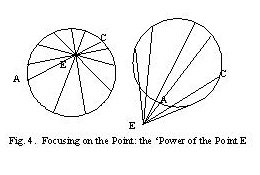- About MAA
- Membership
- MAA Publications
- Periodicals
- Blogs
- MAA Book Series
- MAA Press (an imprint of the AMS)
- MAA Notes
- MAA Reviews
- Mathematical Communication
- Information for Libraries
- Author Resources
- Advertise with MAA
- Meetings
- Competitions
- Programs
- Communities
- MAA Sections
- SIGMAA
- MAA Connect
- Students
- MAA Awards
- Awards Booklets
- Writing Awards
- Teaching Awards
- Service Awards
- Research Awards
- Lecture Awards
- Putnam Competition Individual and Team Winners
- D. E. Shaw Group AMC 8 Awards & Certificates
- Maryam Mirzakhani AMC 10 A Awards & Certificates
- Two Sigma AMC 10 B Awards & Certificates
- Jane Street AMC 12 A Awards & Certificates
- Akamai AMC 12 B Awards & Certificates
- High School Teachers
- News
You are here
Mathematics as the Science of Patterns - Jacob Steiner and the Power of a Point
Jacob Steiner lived from 1796 until 1863. He was a fascinating figure in the history of mathematics not only because of the depth and originality of his geometrical work but also because of his unique educational background. For he was born to a poor peasant family that could hardly afford to send him to school; he could not even write before the age of fourteen! Luck came, however, in the form of the great Swiss educational reformer, Johann Heinrich Pestalozzi, who discovered Steiner, and, in 1814, enrolled him in his school at Yverdon. Later, in an application to the Prussian Ministry of Education written in 1826, Steiner credited Pestalozzi’s methods in forming his general approach to mathematics, his desire to find “the deeper bases” of mathematical theorems (see Burckhardt, 1970 ).
In 1826, the same year he wrote the application just mentioned, he also wrote a long article entitled “Einige geometrische Betrachtungen” (“A Few Geometrical Observations”) (Steiner, 1971 , I, pp.17-76). It is in this work that Steiner defines the "power of a point." To do this, Steiner refers to the Euclidean propositions discussed above but shifts the focus from the chords AC and BD to the point E (see fig. 4).[i] Since the product AExEC for any chord AC through E is the constant value |r2-d2|, Steiner defines the "power of a point (Potenz des Puncts) E with respect to a given circle" to be this invariant number. Incidentally, one ought to note that when the point E is outside the circle, the power of E is just the square of the tangent from E.

The shift from the chords in a circle to a point is more significant than it might seem at first. The power of a point is not a property of a point, for, unlike chords in a circle, points in geometry really have no properties; the power of a point is a relation at a point with respect to a circle and having the form A2-B2=constant; it is, indeed, the recognition of a certain pattern. Accordingly, Steiner precedes the definition of the power of a point with a geometrical locus having, ostensibly, nothing to do with circles—rather, a locus connected to the form A2-B2=constant. He notes that if Mm is a line segment containing the point G and PG is perpendicular to Mm at G, then if P is any point on PG, we have MP2-mP2=MG2-mG2, which is constant since M, m, and G are fixed. (Fig. 5) The proof follows immediately by the Pythagorean theorem: MP2-MG2 =PG2 and PG2=mP2-mG2, so MP2-MG2= mP2-mG2, or MP2-mP2=MG2-mG2.

Since the converse also follows easily, Steiner can state that the locus of points whose distances D and d from two fixed points M and m satisfy the relation D2-d2=constant lies along a straight line perpendicular to the line Mm. Following this and the definition of the power of a point, Steiner develops these ideas in a series of beautiful theorems and constructions that fully justify Hardy’s statement that “A mathematician, like a painter or a poet, is a maker of patterns.”
[i] It is interesting to note at this point that when Descartes’ younger contemporary, Spinoza, wanted to show that an infinity of things (existent and non-existent) are comprehended in the idea of God, he used Elements III.35 as an illustration of his argument (Ethics, Part 2, prop. viii). Spinoza supplied no diagram, but, it seems clear that a diagram like figure 4 is what he had in mind. (The connection between my discussion and this part of Spinoza’s Ethics was pointed out to me by Joseph Cohen of St. John’s College in Annapolis, Maryland).
Michael N. Fried, "Mathematics as the Science of Patterns - Jacob Steiner and the Power of a Point," Convergence (August 2010)




